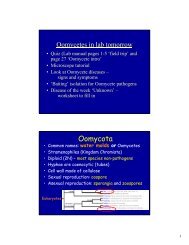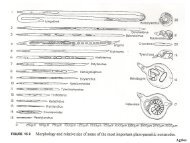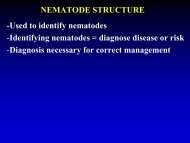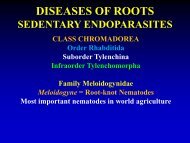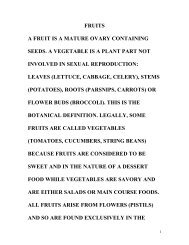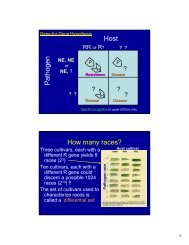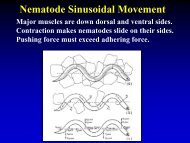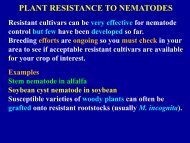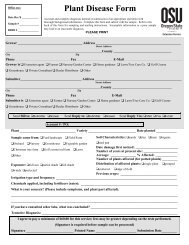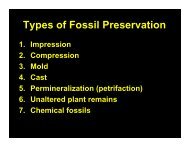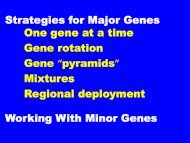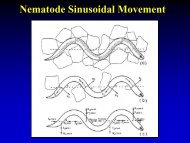BOT 552: PLANT DISEASE MANAGEMENT
BOT 552: PLANT DISEASE MANAGEMENT
BOT 552: PLANT DISEASE MANAGEMENT
- No tags were found...
Create successful ePaper yourself
Turn your PDF publications into a flip-book with our unique Google optimized e-Paper software.
<strong>PLANT</strong> <strong>DISEASE</strong> <strong>MANAGEMENT</strong>Major PrinciplesGeneral ConceptsTerminology
Plant Pathology in PracticeGoals/Objective Knowledge/Concept-diagnosis -recognition of symptoms, signs Bot 453/553-pathogen biology-prognosis -disease cycles Bot 350/550-principles-control -control strategies and tactics-quantitative application-cropping system managementBot <strong>552</strong>
Major Principles of Plant Disease ManagementStrategies before pathogen is presentExclusion = attempts to prevent introductionor establishment of pathogenStrategies after pathogen is presentTherapy = procedures once pathogen becomesestablished
B. Avoidance of the Pathogen– Avoiding disease by planting:1. at times when inoculum is inactive or wheninoculum levels are low, or2. in geographic areas or planting sites in a localarea where inoculum is absent or the environmentis unfavorable.Common to grow seed in areas away for commercialproduction to avoid pathogens.
C. Eradication of the Pathogen– Reducing, removing, eliminating, or destroyinginoculum at the source, either from an area orfrom an individual plant in which it is alreadyestablished.1. Rotation to crops which cannot sustain pathogen2. Treatment of source of inoculum with chemicals,heat, etc. = soil sterilization for potting mix,fumigation3. Eradicant fungicides4. Biological control of plant pathogen
D. Protection of the Plant– Eliminate or reduce the effectiveness of inoculum atthe site of infection by imposing a barrier betweenthe plant and the pathogen.1. Chemical spraying or dusting of foliage2. Seed treatment3. Protectant fungicides
E. Resistance of Plant to Pathogen– Reduces effectiveness of inoculum, therebyreducing establishment of the pathogenF. Therapy Applied to a Diseased Plant– Cure or minimize losses in diseased plants by usingchemotherapeutants or by altering the severity ofattack by manipulating the environment to reducedisease response.
<strong>PLANT</strong> <strong>DISEASE</strong> <strong>MANAGEMENT</strong>General Concepts
Disease TriangleHostTotal of all properties that affect susceptibilityPathogenTotal of all properties of pathogen(virulence, abundance, etc.)EnvironmentTotal of all conditionsthat affect diseaseAll three factors are necessary components of diseaseIf components could be quantified,Area of triangle would represent amount of disease.
Vanderplank’s Equivalence Theorem“Effects of host, pathogen and environment can betranslated into terms of the rate parameter of anepidemic”Changes in any component has an equivalent effecton disease- More-less susceptible host All affect- More-less aggressive pathogen amount of- More-less favorable environment disease
Therefore, disease management principlesand practices are often centered around theconcept of the Disease Triangle so thatmanagement tactics often seek tomanipulate one or more of the componentsof the disease triangle.
Disease CyclesIndependentof host“All pathogens gothrough a cycle withsimilar events.”Knowing how particular pathogens go throughtheir disease cycle is important in developingmanagement strategies.
Understanding how disease cycles relate to diseaseseverity is assisted by the discipline of EpidemiologyEpidemiology is “the study of factors affecting theoutbreak and spread of infectious diseases”Or:the study of disease in populations, how diseasesincrease over space, in severity, or over time.
A central concept to epidemiology is that differentpathogen populations have different disease cycles.I. Monocyclic = single cycle (simple interest)I. Pathogens that complete one or even part of onedisease cycle/year are called monocyclicIn monocyclic pathogens the primary inoculum isthe only inoculum available for the entire season.There is no secondary inoculum and no secondaryinfection.The amount of inoculum produced at the end of theseason, however, is greater than at the start of theseason so the amount of inoculum may increasesteadily from year to year.
DiseaseThis representation of plant disease over time isreferred to as a “Disease Progress Curve”Graphically, disease caused by monocyclicpathogens looks like a saturation curve.Monocyclic DiseaseTime
DiseaseRate of increase of disease over time can berepresented by a simple interest function.Monocyclic DiseaseTime
Examples of Monocyclic DiseasesBlackleg of potato (Erwinia caratovora)Verticillium wiltCereal Cyst Nematode
II. Polycyclic = multiple cycles/year (compound interest)Most pathogens go through more than one (2-30) disease cyclein a growing season and are referred to as polycyclic.Only a small number of sexual spores or other hardy structuressurvive as primary inoculum that cause initial infections.Once infection takes place, large numbers of asexual spores areproduced as secondary inoculum at each infection site.These spores can produce new (secondary) infections thatproduce more asexual spores and so on.With each cycle the amount of inoculum is multiplied manyfold.
DiseaseGraphically this type of population growthis represented as a sigmoid curvePolycyclic DiseaseTime
DiseaseRate of increase of disease over time can berepresented by a compound interest function.Polycyclic DiseaseTime
Many of these pathogens are disseminatedprimarily by airOr air-borne vectors and are responsible for mostof the explosive epidemics in most cropsExamples of Polycyclic DiseasesDowny mildewsPowdery mildewsLate blight of potatoLeaf spotsBlightsGrain rustsAphid borne virusesRoot-knot nematodes
III. Polyetic (multi-year) cyclesSome pathogens take several years before inoculumthey produce can be disseminated and initiate newinfections.May not cause many new infections over a given areain a year, amount of inoculum does not increasegreatly within a year.However, because they survive in perennial hosts theyhave almost as much inoculum as they had at the endof the previous year.Inoculum may increase steadily (exponentially) fromyear to year and can cause severe outbreaks whenconsidered over several years.
Examples of Polyetic Diseases:Some diseases of treesDutch elm diseasePear declineCitrus tristezaFungal vascular wiltsMycoplasmal yellowsViral infections
Implications for Disease Management StrategiesMonocyclic DiseasesReduce the amount of primary inoculum, or affectthe efficiency of invasion by the primary inoculum.Polycyclic DiseasesReducing the amount of primary inoculum has lessimpact.Reducing the rate of increase of the pathogen morebeneficial.
Other Concepts Related to Disease CyclesSuccessful Infections => symptomsBefore symptoms:Incubation period = time between inoculation andpenetration and appearance of the disease symptom.The length of the incubation period of differentpathogens/diseases varies with:1. the particular pathogen-host combination2. the stage of development of the host3. the temperature in the environment.Can make disease assessments misleadingIf infections are presymptomatic during scouting.
Latent period = time from infection untilproduction of new inoculum (reproduction).Duration can have a large effect on the rate of theepidemic.Affected by characteristics of the host (stage ofdevelopment, age of tissue, physiological condition),the pathogen,and the environment (temperature, moisture).
Propagule NumberGradients in pathogen densities and disease arefrequently observed.Factors that affect spatial variation in the amountof incoming inoculum lead to dispersal gradients.Dispersal Gradient CurveSource ofinoculumDistance (m or km)
Percentage DiseaseGradients in pathogen propagule density can result inDisease gradients = change in disease severity along astraight line away from the source of inoculum.Disease Gradient CurveSource ofinoculumDistance (m or km)
The percentage of disease and the scale for distancevary with the type of pathogen or its method ofdispersal, being small for soilborne pathogens orvectors and larger for airborne pathogens.Disease gradients can also be caused byenvironmental gradients such as, variations in soiltype, fertility, or gradual changes in microclimate.
Disease IntensityVariation in pathogen density as the result ofdispersal gradients or other causes are importantrelative to the impact of a Dose Response on disease.Dose-Reponse CurveInoculum Dose
DiseasePurpose of disease management is to prevent diseasefrom exceeding some level where profit or yield issignificantly diminished.Effect of Management on DiseaseMonocyclicDiseaseManagementUnmanagedDisease Level= Crop LossManagedDisease LevelPolycyclicTime
Principles of epidemiology indicates that controlmeasures can do this in only two ways.1. They may reduce (or delay) disease at the beginningof the season (x 0 ) or2. They may decrease the rate of disease development(r) during the growing period.
Ways to reduce disease (inoculum) at beginning (x 0 )Affects monocyclic and polycylic diseasesFumigation Certified seedSanitation Seed treatmentsQuarantine Host plant resistanceWays to decrease the rate of disease development(infection rate) (r)Change the environmentFertilizer applicationHost plant resistanceWays to change t (see “b” on figure)Harvest early before disease becomes severe.Plant early (cereal cyst nematode)
Control of different diseases requires differentstrategies.Some pathosystems, monocyclic and polyetic diseasescan be effected by use of an x 0 -reducing practice only.However, for most diseases more than one controlprocedure is used and these are often chosen toreduce x 0 and r.These integrated control measures use a combinationcultural methods, resistance breedingregulatory actions, chemical control measures
Management Strategiesa Sanitationb Change planting datec Partial host resistanced Eradicant fungicidee Protectant fungicidef Adult plant hostresistanceEffects on Disease1. Original progress curve2. Disease reduced byreducing x 0 (a & d) or bydelay of epidemic (b & e)Rate same as curve 13. Rate changed afterdisease has begun (f)4. Rate changed frombeginning (c)Zadoks and Schein, 1979



